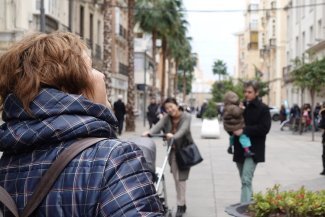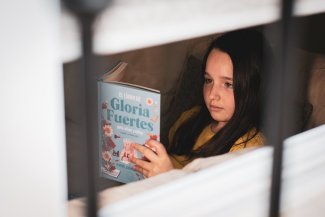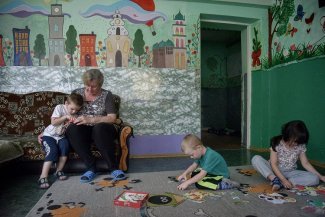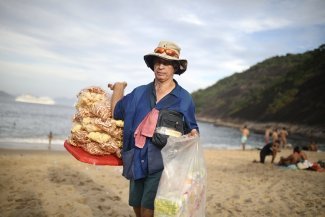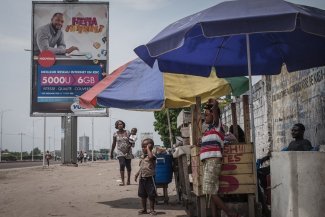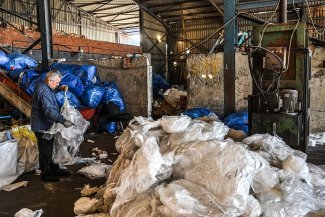Children play at the Holistic Actions for Development and Empowerment training centre in Kampala, Uganda, which recently won a 2022 Real Play City Challenge Award for creating a space where play supports climate action.
Adriana Quiñones’ neighbourhood on the eastern side of Cali in Colombia, is a mass of irregular vertical housing blocks. Children’s play areas seldom appear among the exposed brick, flat roofs and concrete roads. But the main reason the 16 year old grew up afraid to play outside was the violence.
“My neighbourhood provoked a lot of fear,” she says in a video describing the impact of an initiative to improve the community for children. “Fear of going out and not knowing whether someone would shoot you.”
The United Nations Convention on the Rights of the Child (UNCRC) states that children have a right to relax and play. Outdoor play is fundamental to a child’s physical and mental development. Among many benefits, children who are physically active have a reduced risk of chronic diseases such as obesity, cardiovascular disease and type 2 diabetes. Play can help children increase resilience, self-regulation and skills for dealing with stress.
But many factors prevent children from accessing outdoor play, especially in cities. Violence prevented Adriana, but another problem was the informal development of her locality, without considered planning of how land-use and construction might affect children.
Tim Gill, author of Urban Playground: How Child-Friendly Planning and Design Can Save Cities, says children are “invisible” when it comes to city planning, which tends to be driven by economics. This is despite the fact that by 2050, almost 70 per cent of the world’s children will live in urban areas, according to the UN children’s agency, Unicef.
“Children lose out because of that economic focus,” says Gill. “They don’t have a direct say over politics – they are dependent on adults and institutions looking out for their interests.”
Poor urban planning and design hurts children more than any other demographic group, Gill adds. “It leaves children less healthy from pollution and inactivity, and simply from road danger.” Road traffic injuries are the leading cause of death for children and young adults aged between five and 29 years old, according to the World Health Organization.
To address this problem, Gill advocates using a “children’s lens” in city design. This means having adults thinking about children, but also engaging children themselves in discussions and decision-making. Gill suggests this approach will lead to long-term outcomes and future societal benefits, rather than short-term, potentially damaging solutions.
Addressing the “play gap”
Such typical city challenges, and Gill’s recommended approach to tackle them, are illustrated by the work of NGO Despacio’s project Vivo Mi Calle in Cali since 2019. For example, when the municipality built a pedestrian bridge built over an exposed sewage pipe, specifically to connect housing areas with the neighbourhood school, they did not consider if the design was suitable for children. It was not. The bridge was so wide that motorcycles and cars used it to avoid the congested main roads. It also acted as an “invisible border” set by territorial gangs, meaning that children risked being attacked if they were from the ‘wrong’ side. “It was not safe for children,” says the charity’s health cities lead Lina Quiñones (no relative). “People sat on and under the bridge to do drugs.”
To restore the safe school route, Vivo Mi Calle worked with community leaders to put planters on the structure, preventing cars from crossing, and forcing motorcycles to slow down. It consulted with community leaders to agree that local people would take responsibility to upkeep the bridge, deter drug-users, and speak to gang leaders about respecting children’s safety. The NGO asked children their opinions on how to rejuvenate the area. They said it looked dull, and so they painted the concrete together in bright red, blue, yellow, white and green squares. They also installed WiFi on the bridge. “It’s actually called the Bridge of Colours now,” says Lina Quiñones. “It’s now a safe space for children to play, and to go and do their homework.”
Vivo Mi Calle’s impact was recognised by an international award last year called the Real Play City Challenge. This honours cities and urban practitioners that provide opportunities for play and use play to tackle global challenges. It is organised by the Real Play Coalition, a non-profit alliance between National Geographic, the LEGO Foundation, IKEA, sustainable development professional services firm Arup, and Unicef. PlacemakingX, a network of global leaders aiming to reinvent public spaces, is a partner for the award.
Arup associate director Sara Candiracci says a “play gap” exists in cities. Decision-makers know play is something kids do, but do not fully understand its significance, particularly in early childhood.
“The first five years of a child’s life is so important, because that’s when 80 per cent of the brain develops,” she says. “The environment where they grew up, the type of human interaction and stimulations they have…can grow strong foundations for their wellbeing and future development.”
The coalition has responded to this gap by collecting evidence to promote the benefits of ‘playful cities’ and how to retro-fit them. The award is one way the team has raised visibility for solutions implemented by communities and city authorities. With other partner organisations, Arup has also created a Proximity of Care Design Guide that explains how urban planners, designers, developers, city leaders and early childhood development practitioners can embed child and family-friendly design principles into their work.
This is particularly important in low-income countries where recreation and playful learning opportunities for children may be limited, Candiracci emphasises. But one winner among the Real Play City Challenge awards from Kampala, Uganda demonstrated change is possible even with little funding or planning.
Communities driving change
It began when local NGO Holistic Actions for Development and Empowerment (HADE) executive director Ahumuza Rhona observed parents living in an informal settlement were working hard to raise money to feed their families. Children were often left alone or having to accompany them to work, leaving few opportunities to play.
To address this, HADE set up training opportunities for young mothers to learn income-generating skills, such as tailoring. At the training centre, they also created an enclosed garden space where children can play. “We have somebody there to watch them and ensure their safety and security,” says Rhona.
The project also tackles environmental concerns, as it teaches the mothers to recycle materials found during community clean-up sessions, and turn them to items to sell including rugs and toys. Equipment in the play area is also made of reused items. HADE volunteers created a giant alphabet machine with spinning letters out of old metal, tyres and flip-flops. The children built a towering Christmas tree sculpture out of used plastic bottles. HADE also created a vegetable garden at the site, and provides balls and chess sets.
The Real Play City Challenge awarded HADE as a result of these efforts in its ‘places where play supports climate action’ category. “It has helped children improve their mental capacities,” says Rhona. “They are engaged instead of roaming in the community. With this initiative we have also worked to sensitise the local leaders to highlight the importance of children’s play.”
Change can be driven up from communities, but also from national and local government level downwards. In India, the national Ministry of Housing and Urban Affairs launched a Nurturing Neighbourhoods Challenge for cities in 2020. This prompted Kohima City in the north-eastern state of Nagaland to assess how well it was serving its children. Because of a unique land holding system in the area, whereby tribal communities own land, little space was allocated for children’s play. The land is also hilly and densely developed.
“We were exploring avenues to develop play areas for children,” explains Niepukhrie Tepa, senior data officer at Kohima Smart City Development Limited (KSCDL), a company established to implement improvements in the area, and another Real Play City Challenge winner. He says as children could only play in the streets, many tended to spend their time indoors at home. “A community came forward to identify a space – a former dumping yard,” says Tepa. Together, the Forest Colony Community and KSCDL converted the wasteland into a ‘pocket park’ with a playground and seating for adults.
As well providing health benefits for children, the park has improved community cohesion as it brought together caregivers. This was particularly important during the Covid-19 lockdowns when children were home-schooling. “It’s something new for Kohima City to specifically look at development projects through the lens of infants and toddlers and caregivers,” says Tepa. “But we’re going to incorporate this idea in more and more projects.”
Making sure no child is left behind
Since 1996 UNICEF has used the UNCRC as a foundation on which to encourage cities and municipalities of all sizes to become more child-friendly through its Child-Friendly Cities Initiative (CFCI). It does this by promoting partnership building between local stakeholders including government, communities and children themselves.
Cities that sign up to the initiative must commit to supporting meaningful child participation in their city planning, and eliminating discrimination against children. They must review children’s situation in their locality, including how their rights are upheld. The municipality next develops an action plan to address any urgent needs and commits funding to remedy the problems. After an agreed period of time, UNICEF assesses if the area has achieved tangible results and can award it a Child Friendly City logo.
The initiative has been implemented in 42 countries so far, in more than 3,000 municipalities. These include Finland, Malawi, Iran and Georgia. “Each has very, very different contexts and challenges,” says UNICEF local governance policy specialist Diana Vakarelska. “It can be improvement of schools, street safety, better lighting on streets, development of green spaces and playgrounds, or addressing issues related to violence against children.”
But keeping children in governments’ focus has become harder in recent years as many countries experience multiple crises, Vakarelska says. Covid-19, conflict, climate change and economic downturns are taking their toll.
“The challenge is to keep the fiscal space for children and make sure that child priorities are not left behind,” she urges.
In Cali, Adriana has no doubts about how a child-centred approach has impacted her neighbourhood. “It changed the colours, the atmosphere, and young people and their way of thinking,” she says. “I can see everyone transforming not only their community, but also their city, and even the country.”




